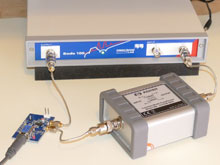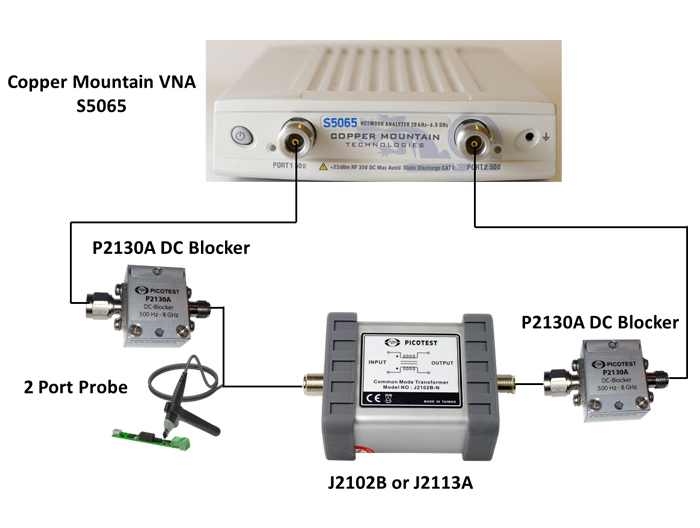What's included
J2102B Common Mode Transformer - BNC or N Type Connector
![]() User manual
User manual
1 Year Warranty
2-Port Shunt-Through Measurement using the J2102B and the Bode 100 VNA

2-Port Shunt-Through Measurement using the J2102B and the Copper Mountain S5065

| Model | Description |
| J2102B-BNC | J2102B Common Mode Transformer – BNC Connectors |
| J2102B-N | J2102B Common Mode Transformer – N Connectors |
The simplest and most effective method for eliminating a ground loop is to add a wideband common mode transformer to the measurement, such as the Picotest J2102B Common Mode Transformer. The transformer for a low impedance PDN measurement must have very wide bandwidth, low loss and tight coupling, otherwise, the results will not be accurate over the measured frequency range. It is also important to maintain the 50 Ohm transmission line impedance through this transformer. The J2102B accomplishes this with ease.
Features
- Greatly attenuates the effects of low frequency ground loops
- Supports the 2 Port Shunt Thru impedance measurement required for Power Distribution Networks (PDN’s)
- Ultra-low noise output - Ultra-high ripple rejection
- Two output connector versions, BNC and N
- Maintains 50 Ohm transmission line integrity to at least 6GHz
- Works with all types of test equipment to eliminate ground loops, such as Network Analyzers, Oscilloscopes and Spectrum Analyzers
2-Port Shunt-Through Measurement using the J2102B and the R&S ZNL

2-Port Shunt-Through Measurement using the J2102B and the R&S ZNL

2-Port Shunt-Through Measurement using the J2102B and the R&S ZNL

2-Port Shunt-Through Measurement using the J2102B and the Copper Mountain S5065

2-Port Shunt-Through Measurement using the J2102B and the Copper Mountain S5065

Detailed Specifications
| Specifications | ||
| Characteristic | Rating | |
| 3dB Bandwidth | 1Hz-6GHz | |
| Insertion Loss | TBD | |
| Return Loss | TBD | |
| Maximum Voltage | 50V | |
| Temperature Range | 0-50C | |
| Maximum Altitude | 6000 Ft | |
| Absolute Maximum Voltage | < 50VAC and 75VDC | |
![]() Caution: To avoid equipment damage and/or severe injuries or death ensure that the absolute maximum ratings are observed and not exceeded at all times.
Caution: To avoid equipment damage and/or severe injuries or death ensure that the absolute maximum ratings are observed and not exceeded at all times.
